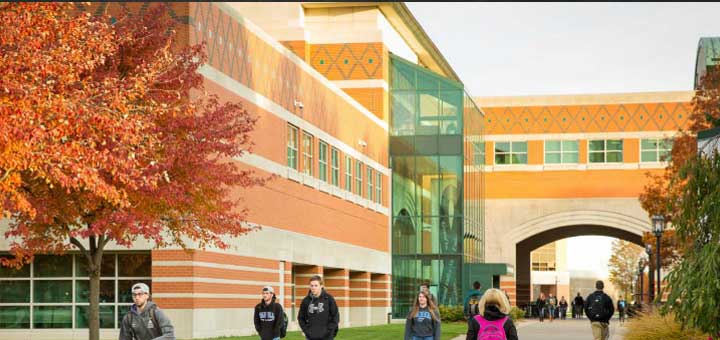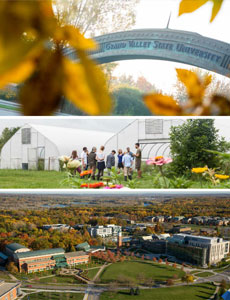Coffee News
One of the nation’s pre-eminent college sustainability offices
Norman Christopher, Executive Director of the Grand Valley State University (GVSU) Office of Sustainability Practices, is fond of invoking the ethos, as well as the very words of former cultures that were wont to treat the earth with reverence, and whose wise ones well understood humankind’s role in helping to preserve, in perpetuity, the beauty and resources of the natural world.
“There’s a Native American proverb,” he says. “‘We do not inherit the earth from our fathers; we borrow it from our children.’ That’s a pretty good one from over 200 years ago. Here’s another one from an African elder: ‘Enough for all, forever.’ Both cultures had a good understanding of stewardship; of taking care of things that you’re given and service to others because we are passing on our current state to the next generations. And unless we do a much better job of addressing these major issues using sustainable development best practices, we’re going to be in a very difficult position.”
Thus, as leader of one of the nation’s pre-eminent college sustainability offices, Christopher’s aim is, and always has been, to try and prevent that potentially “difficult position” from ever happening by reimagining the ways in which the university and its community could grow and nurture a new culture of stewardship based on verifiable sustainable practices that would be a model for other campuses and communities nationwide. “It started in earnest in 2004-05,” he relates. “And during that time-frame, we’ve grown from a sustainability initiative, to the Sustainable Community Development Initiative, to now, what we’re called, which is the Office of Sustainability Practices.”
The stated purpose of Christopher’s office is “to provide the necessary skills, processes, tools, and resources to address global, national, regional, and local sustainability issues through curriculum, activities, internships, and service learning projects that promote awareness and improve performance through the application of sustainable development best practices.” Its mission is “to provide Grand Valley administration, faculty, staff, students, and community stakeholders with the required skills and capabilities to become better stewards and responsible global citizens in the workforce, communities, and family life.”
By instituting many university-wide programs and defining all the ways in which they promote best sustainability practices, the Office has also led the way in inculcating sustainability concepts deep into the University’s core value system; sustainability is now one of seven stated values in its strategic plan.
Established in 1960, the University now has eight degree-granting colleges and more than 25,000 students. The main campus is in Allandale, Michigan, with another major branch, the Robert C. Pew Campus, in downtown Grand Rapids. Other GVSU locations include: Holland, Muskegon, Traverse City, and Detroit. The combined colleges offer more than 200 areas of study, over 80 undergraduate degree programs, and 40 graduate programs. Christopher says that his Office is “a service to all the departments on campus and all colleges.”
By way of the many accolades the Office has earned for GVSU over the last several years in the area of best sustainability practices, it would be difficult to deny that both its purpose and mission are being successfully carried forward. For example, for the sixth year in a row, Grand Valley was named one of the country’s “Most Environmentally Responsible Colleges” by The Princeton Review in its 2015 Guide to 353 Green Colleges. For the third year in a row, it received a Gold Rating from the Association for the Advancement of Sustainability in Higher Education (AASHE) – one of 69 institutions nationally to achieve that certification, and the first one in Michigan. Grand Valley was also named “One of the Country’s Greenest Universities” by the Sierra Club for the third year in a row – the highest ranked Michigan institution on the list.
Documenting the energy savings accrued from applying best sustainability practices in his domain is what Christopher calls the “applied research; the work side of sustainability.” And, however pedestrian the gathering of data may be, that type of research does provide the key metrics which help prove – with actual numbers – what best sustainability practitioners have long been promising. “Most of the research work we do is directed to documentation of energy savings and other environmental stewardship metrics,” he says. “We have the numbers of what we looked like consuming energy in 2003 as a baseline, so we now know exactly where we stand 12 years later.”
Yumiko Jakobcic is the Office of Sustainability Practices’ Campus Sustainability Manager. Her statement of overall energy savings over the past years is succinct: “We’ve been able to reduce our energy use quite a bit,” she says. In fact, over the past fifteen years, GVSU has reduced its electrical consumption by 26.5 percent, natural gas consumption by 27.5 percent, and water/sewer by 42.7 percent on a square foot basis. James Moyer, Associate Vice President for Facilities Planning comments, “We realized that we had little control over the cost of energy, but we could control the amount we used. We embarked on a campus wide effort to control use.” Christopher attributes some of the water consumption reduction to “new drainage and aquifers and irrigation ponds that we didn’t have that now provide water for our recreation fields and other places.” Moyer adds, “We also realized that we had to control water consumption as part of the energy control effort; we migrated to more efficient water using facilities on all new construction and any replacements. This helped us reduce the amount of energy used to deliver the water to the point of consumption.”
Indeed, as Grand Valley grows, its energy use actually shrinks. And so do the bills. By the end of 2015, the University will have avoided energy costs of a conservative $2.2 million annually through the use of energy-efficient practices and procedures. It continues to save $2 million a year with ongoing projects, such as switching light bulbs to LEDs (Light Emitting Diodes), and another $1.5 million that it saves annually through other projects that Jakobcic calls, “one-time saving programs,” like its semi-annual energy competition. These savings are substantial considering the utility bills average $6.5 million per year over the past fifteen years. Credit should be given to Facilities Services for implementing these successful programs.
A large chunk of Grand Valley’s energy savings comes from the school’s building practices which have helped it achieve an impressive portfolio of LEED (Leadership in Energy and Environmental Design) certifications from the U.S. Green Building Council. LEED buildings use 30 percent less energy, 40 percent less water, and generate 75 percent less waste material than regular buildings. “We probably rank as one of the highest in the nation in the number of campus LEED buildings,” Christopher says. “We have 20 LEED certified buildings of various types. We have one Platinum – the library (in 2014, the Mary Idema Pew Library was awarded LEED Platinum status); we have two Gold, and most are Silver, but the key is, we build to nothing lower than a LEED Silver for all of our buildings on campus. That means the buildings are commissioned and certified and we can track their performance. Not every college and university spends monies to do that.” LEED buildings comprise 1,391,128 million square feet of GVSU’s 5,565,571 million total square feet of built facilities. Facilities Planning has continually raised the bar regarding green and LEED building standards and applied sustainability best practices.
And even more monetary savings are on the way, as the University, in partnership with Consumers Energy, the local public utility, has just broken ground for a solar “garden” to be built on the Allendale campus. The university is serving as the host, while the utility company is taking care of the design, construction, and maintenance of the solar garden. According to Jakobcic, the array of 11,000 photovoltaic, solar panels will cover an area of 17 acres, providing about three megawatts of power – the equivalent of the electricity used by 540 average Michigan homes. The university subscription amount is for 500kW and will be the largest renewable energy endeavor thus far. When complete by spring 2016, Christopher says the solar farm will be the largest community solar photovoltaic power generator in the state of Michigan to date using a distributed grid model.
In order to expand and reinforce the holistic nature of the sustainability paradigm, GVSU has implemented many other sustainable programs and practices throughout its campuses. For example, students recycle a variety of products, including plastics, paper, metal, glass, motor oil, light bulbs, batteries, ink cartridges, computers, food waste, and more. Each winter the school competes against other universities nationally in RecycleMania, a national tournament to recycle the most. Last year, Grand Valley took sixth place in the nation in the composting category, and took first in the state and 24th place in the nation as a Grand Champion. The category is based on the total percentage of overall waste that is recycled during the competition.
“We’re very fortunate on this campus to have compost in addition to recycling,” adds Jakobcic, “so we’re able to divert quite a lot of our waste from the landfill. We ranked second in the nation in the waste minimization category for the “Game Day Challenge” of RecycleMania because we were able to divert about 80 percent [of recyclable materials] at one of our football games.” In fact, all campus-wide efforts to minimize waste have helped reduce the amount of trash sent to the landfill by about 10,000 pounds each week.
As a signatory to the American College & University Presidents’ Climate Commitment, known as the ACUPCC, the University is required to complete a greenhouse gas inventory as well as have a climate action plan on campus. The ACUPCC’s goal is getting commitments from its 665 member institutions to reduce, and eventually eliminate, their net greenhouse gas emissions from specified campus operations. Between 2007 and 2012, ACUPCC institutions reduced their total greenhouse gas emissions by 10.2 MtCo2e (metric tons of carbon dioxide).
GVSU’s transportation initiatives have also helped to lower the school’s carbon footprint. Nearly half of the school’s students use public transportation, and all bus routes on The Rapid, operated by the Grand Rapids Metro Area Transit Authority, are free for students, faculty, and school staff. “We have one of the highest rates of bus rides – with 2,898,032 rides last year,” says Christopher. “We’ve been able to save millions of gallons of fuel each year and reduce our carbon footprint. Our transportation program has been very successful.” The partnership with ITP Rapid and GVSU’s Campus Operations has been in place for 15 years. The school also partners with a rideshare matching program called GreenRide, which is available to everyone in the greater Grand Rapids area and surrounding counties. It pairs drivers with riders from similar locales who have similar commute schedules.
GVSU also has an inexpensive bike rental program, as well as its own bike shop, where tools are available for self-service maintenance. In addition, trained mechanics are on site to assist with any necessary repairs. “Students are renovating and maintaining bikes through our recreation department. They also provide rental opportunities for students interested in alternative transportation,” says Jakobcic.
Grand Valley also has a sustainable agriculture project that has students growing food right on campus. “We have a farm manager and four student interns and tons of student volunteers,” says Jakobcic. The Sustainable Agriculture Project recently passed the Michigan Food Safety Risk Assessment which now allows it to operate as if it was a small farm. That means that the university can serve its own produce in the campus dining halls. “There are tremendous academic opportunities associated with the farm through internships and class visits. We have a Sustainable Food Systems certificate that’s based out of the farm and there are a lot of classes that meet and use it, basically, as an outdoor classroom,” says Jakobcic.
Interestingly, GVSU does not offer a Sustainability Degree. “But we do offer ‘Education for Sustainable Development,’ or ESD, in the forms of sustainability emphases, certificates, themes, and some majors and minors,” explains Christopher. In addition, says Jakobcic, the school has “over 200 sustainability-related classes that are spread throughout the curriculum and in all different academic areas.” For example, a Green Chemistry Certificate can be granted concurrently with a Bachelor’s Degree in Chemistry. There are certificates in Sustainable Food Systems, Sustainable Urban and Regional Planning, and Sustainability in Public and Non-Profit Organizations. Majors include Liberal Studies with an Emphasis in Sustainability; Geography and Urban Planning; and Natural Resources Management. Minors include Natural Resources Management and Environmental Studies.
Christopher says that he also tracks the skill sets that those programs offer “and then I match them to the marketplace, and that’s how students are beginning to find jobs in sustainability here in West Michigan. Grand Valley is very unique in that it keeps over 85 percent of its students in Michigan. We educate our students in applied best practices and they stay here,” he says, proudly. So, in Christopher’s quest to train the next generation of sustainable practitioners, the Executive Director has been a dynamic force in reaching out to other organizations and forming partnerships wherever he can find like-minded institutions that share a common agenda. In 2005, Christopher’s Office started a partnership with the City of Grand Rapids. “Our relationship with the City that has progressed into a trustful working partnership over the years where our students are being placed in associate positions with the City in transformational research and analysis, social media, and applied sustainability best practice areas that improve overall social, environmental, and economic impact,” says Christopher.
“Outreach is probably one of our strongest areas,” he reports. “In 2005, Grand Valley was a charter member in forming our Community Sustainability Partnership (CSP) in Grand Rapids. Today, the CSP has 250 endorsing partner organizations across all sectors.” These member organizations have committed to work together to restore environmental integrity, improve economic prosperity, and promote social equity in the community with the goal of creating and sustaining a positive quality of life for future generations.
“Grand Valley sits on the leadership team, and the Chair has been the Mayor of Grand Rapids. So, what we’ve been able to do is to take sustainability planning and reporting in a side-by-side relationship that we started back in 2004-05 with the city.” The CSP, according to Christopher, is “a networking and capacity building organization that shares the applied best practices of sustainability” with all public, private, municipal, and academic sectors. GVSU is also a member of the West Regional Michigan Community Sustainability Partnership, which is made up of six regional CSPs, partnerships, and coalitions that are committed to developing sustainable neighborhoods and communities. “That ties us to all of the sustainability best practices that are happening in the sectors,” Christopher says.
As if the preceding wasn’t enough to endorse Christopher’s bona fides in the realm of best sustainability practices, he has also recently authored Sustainability Demystified, a practitioner’s guide for businesses, and organizational leaders, managers, and owners that uses local case studies to present ways in which enterprises can reap the benefits of best sustainability practices. “We probably have over 20 best practices of sustainability that businesses have implemented and there is a local case study of each of the companies that is implementing them,” he explains.
“Everybody is a client,” he adds. “Long term, sustainability is about avoiding costs, creating value, and making better decisions that improve social, environment, and economic impact. It’s first about creating awareness for all different institutions, enterprises, organizations, and businesses and letting them understand what sustainability really means.” To emphasize the point, Christopher quotes a contemporary colleague this time – Birgit Klohs, a local economic development leader, who recently opined that “’Sustainability is the DNA of West Michigan.’” Christopher sums up: “When you say that, it’s beyond an individual. It’s beyond a corporation, or an entity, or organization. We’re all, now, looking at a set of applied best practices that could make West Michigan a very attractive region to live, learn, work, and play – and that is the end zone for us.”
______________________________________
AT A GLANCE
WHO: Grand Valley State University Office of Sustainability Practices
WHAT: One of the nation’s pre-eminent college sustainability offices
WHERE: Allandale and Grand Rapids, Michigan
WEBSITE: www.gvsu.edu/sustainability
PREFERRED VENDORS
DeWitt Barrels – DeWitt Barrels specialize in the sales and reconditioning of steel, fiber, and plastic drums of all sizes. The company also sells IBC’s (Intermediate Bulk Containers) and new drums. It was founded in 1893, in Chicago, by Peter DeWitt and his two sons, Peter and William, who began by making and repairing wooden barrels and kegs. – www.dewittbarrels.com
Independent Bank of West Michigan – www.independentbank.com
Synchrony Financial – A provider of private label and co-branded credit cards, installment loans, and a broad suite of services that help grow businesses. The company works with national and regional retailers, dealers, manufacturers, buying groups, and industry associations across many markets including: Automotive Care, Home Furnishings and Flooring, Appliances and Quoin, Inc. (Almond Products) – www.almondproducts.com


